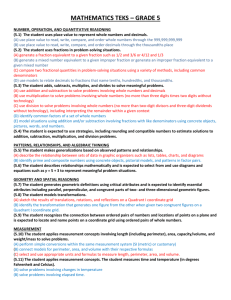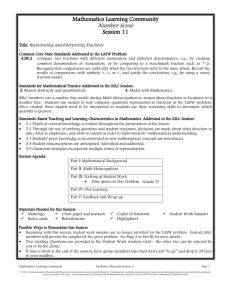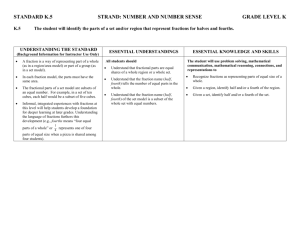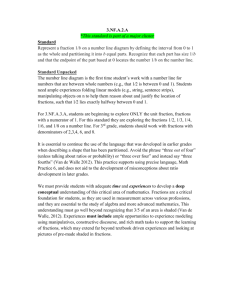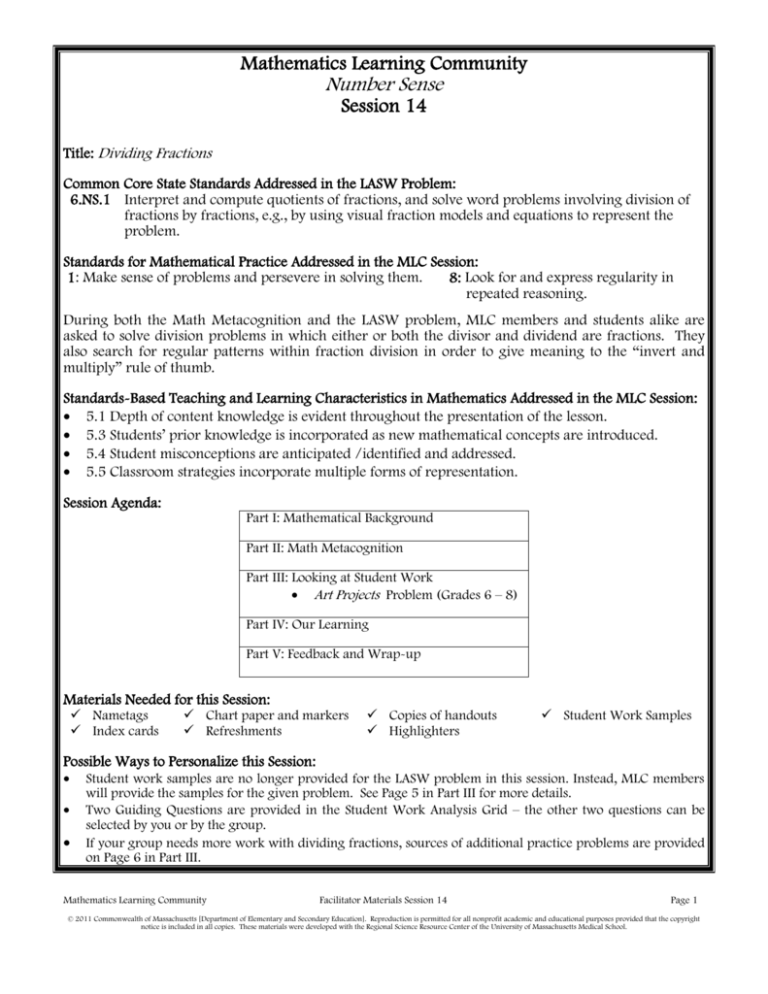
Mathematics Learning Community
Number Sense
Session 14
Title: Dividing Fractions
Common Core State Standards Addressed in the LASW Problem:
6.NS.1 Interpret and compute quotients of fractions, and solve word problems involving division of
fractions by fractions, e.g., by using visual fraction models and equations to represent the
problem.
Standards for Mathematical Practice Addressed in the MLC Session:
1: Make sense of problems and persevere in solving them.
8: Look for and express regularity in
repeated reasoning.
During both the Math Metacognition and the LASW problem, MLC members and students alike are
asked to solve division problems in which either or both the divisor and dividend are fractions. They
also search for regular patterns within fraction division in order to give meaning to the “invert and
multiply” rule of thumb.
Standards-Based Teaching and Learning Characteristics in Mathematics Addressed in the MLC Session:
5.1 Depth of content knowledge is evident throughout the presentation of the lesson.
5.3 Students’ prior knowledge is incorporated as new mathematical concepts are introduced.
5.4 Student misconceptions are anticipated /identified and addressed.
5.5 Classroom strategies incorporate multiple forms of representation.
Session Agenda:
Part I: Mathematical Background
Part II: Math Metacognition
Part III: Looking at Student Work
Art Projects Problem (Grades 6 – 8)
Part IV: Our Learning
Part V: Feedback and Wrap-up
Materials Needed for this Session:
Nametags
Index cards
Chart paper and markers
Refreshments
Copies of handouts
Highlighters
Student Work Samples
Possible Ways to Personalize this Session:
Student work samples are no longer provided for the LASW problem in this session. Instead, MLC members
will provide the samples for the given problem. See Page 5 in Part III for more details.
Two Guiding Questions are provided in the Student Work Analysis Grid – the other two questions can be
selected by you or by the group.
If your group needs more work with dividing fractions, sources of additional practice problems are provided
on Page 6 in Part III.
Mathematics Learning Community
Facilitator Materials Session 14
Page 1
© 2011 Commonwealth of Massachusetts [Department of Elementary and Secondary Education]. Reproduction is permitted for all nonprofit academic and educational purposes provided that the copyright
notice is included in all copies. These materials were developed with the Regional Science Resource Center of the University of Massachusetts Medical School.
Part I: Mathematical Background
Approximate Time: 20 Minutes
Grouping: Whole Group
A. Welcome members of your group to the Math Learning
Community. Remind group of established norms.
B.
Today’s Content:
a. The mathematics during this session focuses on dividing
fractions.
b. What do we need to know in order to be able to divide
fractions?
c. Chart ideas to refer to during the Protocol for LASW.
d. It is important to discuss commonly-held misconceptions
about fractions and division during this session.
i. Notion of the remainder: how does the portion
“left over” after division lead to the concept of
fractions itself? In addition, how can students
make sense of the situation when you have a
fraction of a fractional divisor as a remainder?
ii. Reciprocal:
how does the concept of the
reciprocal play into students’ understanding of
fractions? What role does the reciprocal play in
numerical operations? What misunderstandings
may arise from the use of reciprocals within the
traditional algorithm?
iii. Value of the quotient: Division does not always
result in a quotient that is less than the dividend.
e. Visual models can be powerful tools used to develop
understanding of fraction division, as both a concept and
a skill.
C. Relating Content to the Three C’s Theme:
a. How do the ways in which students learn to divide
fractions relate to the ways in which they divide whole
numbers?
b. Which attributes or properties of whole numbers hold
true for fractions? Which do not?
c. How does context play a role in the development of
fraction sense?
Mathematics Learning Community
Facilitator Materials Session 14
Page 2
© 2011 Commonwealth of Massachusetts [Department of Elementary and Secondary Education]. Reproduction is permitted for all nonprofit academic and educational purposes provided that the copyright
notice is included in all copies. These materials were developed with the Regional Science Resource Center of the University of Massachusetts Medical School.
Part II: Math Metacognition
Approximate Time: 25 minutes
Grouping: Whole Group
A. Problem: The problem used for this session is appropriate for
Grades 6 - 8.
Consider the following problem:
How many
2
' s are in 3?
3
Be prepared to explain how you solved the problem.
B. Solution to Problem: 4 ½
C. Problem Intent: (Note: The problem intent for all Math
Metacognition problems is the same). See Session 2 for more
information. In addition, this problem serves as a good start to
discussing division involving one or more fractions. This problem
also sets up what happens when a remainder, or a fraction of a
fraction, exists.
D. Discuss how each group member solved the problem. Refer to the
sample Problem Solving Strategies on Page 4. Share any strategies
that the group itself did not bring forward. Be sure to provide
enough time for discussion of this metacognition problem. Ask
MLC members:
What mathematics did you call on to solve this problem?
What does the answer to a division problem mean?
What does the fractional part in a division problem mean?
E. A common question that arises with a problem such as this is:
“Why is my answer expressed in halves rather than thirds?” The
visual model of this problem shows 3 as the whole, with 2 as the
3
unit. Therefore when you have
you have ½ of the 2 unit.
1 of
3
3
the original whole remaining,
Students should be exposed to varied
3
models for division of fractions to learn to accurately express what
is the whole and what is the unit.
Mathematics Learning Community
Facilitator Materials Session 14
Page 3
© 2011 Commonwealth of Massachusetts [Department of Elementary and Secondary Education]. Reproduction is permitted for all nonprofit academic and educational purposes provided that the copyright
notice is included in all copies. These materials were developed with the Regional Science Resource Center of the University of Massachusetts Medical School.
Problem Solving Strategies
Visual Reasoning
Represent 3 in 1 portions
Verbal Reasoning
Dole out 2 of these 1
3
3
portions at a time
1 1 2
There are 3 1 ’s in 1. So, there are 9 1 ’s in 3. There are 2
3
3
1 ’s in 2/3. So, the problem comes down to determining
3
how many times 2 divides into 9.
2
3
3
4
4
5
9 divided by 2 is 4.5.
Numerical Method Using Division Algorithm
3
2
3 3 3 9
1
3 4
3
2 1 2 2
2
Visual Reasoning #2
Represent 1 whole based
on the unit given by the
divisor. In this problem,
it’s thirds.
Consider how many 2 ’s
3
are in 1 whole?
1 1 2
In this problem, there is a
whole 2 and a half 2 , so
3
So, there are 3 2 ’s in 1,
2 3
since 1 ½ = 3 .
2
To find out how many 2 ’s
3
are in 3, multiply 3 x 3 =
2
9
1
4
2
2
3
there’d be 1 ½ 2 ’s.
3
Number Line Model
Mathematics Learning Community
Facilitator Materials Session 14
Page 4
© 2011 Commonwealth of Massachusetts [Department of Elementary and Secondary Education]. Reproduction is permitted for all nonprofit academic and educational purposes provided that the copyright
notice is included in all copies. These materials were developed with the Regional Science Resource Center of the University of Massachusetts Medical School.
Part III: Looking at Student Work (LASW)
Approximate Time: 50 minutes
Grouping: Refer to protocol
A. Complete the MLC protocol with the group.
B. Problem: The problem used for this session is appropriate for Grades 6 - 8.
Solve each of the following problems. Draw a model to show your thinking.
A.
Juan has 3 gallons of yellow paint that needs to be put into new containers
for an art project. Each container holds
2
of a gallon of paint.
7
How many
containers can Juan fill if he uses up all of the paint?
5
6
B.
The art class has
of a gallon of paint that needs to be shared equally
C.
among 3 students. How much paint will each student get?
The art class wants to make banners out of construction paper. Each banner
takes 3 yard of paper. How many banners can they make if they have 2 ½
5
yards of paper to use?
C. Solutions: A) 10 ½ containers; B)
5 gallons
18
per person; C)
4
1 banners
6
D. Problem Intent: This problem provides an opportunity to consider a realistic
problem context which involves the three types of fraction division: whole
number divided by a fraction; fraction divided by a whole number; and a
fraction (or mixed number) divided by a fraction. Visual and verbal
reasoning also provide students and adults alike with ways to represent the
operation of division by a fraction or of a fraction in a way that makes more
sense. In addition, working on these problems using the Visual Reasoning #2
Method found on Page 4 also shows why the use of the traditional algorithm
for dividing fractions works.
E. Discuss the following:
a. Strategies used to solve this problem.
b. How much experience have group members had with dividing
fractions?
c. How can other methods and models be used to represent the process
carried out by applying the traditional algorithm?
F.
Misconceptions/Questions that May Arise:
a. M: Refer to Part I for information on fraction misconceptions.
b. Q: Division of fractions is commonly taught to students using the
phrase “invert and multiply,” which highlights the connection
between multiplication and division as well as the concept of the
reciprocal. However, what understanding is lacking from such
instruction? How do students relate the new multiplication problem
to the original division problem?
c. Q: How do students interpret remainders when they occur?
Problems A and C both have a remainder involved. It is important for
teachers to work with these remainders and to determine what they
mean and how the remainders relate to their visual models. For
example, in A, 1 of a gallon remains, yet this amount is 1 of the
2
7
container size being used.
Mathematics Learning Community
Facilitator Materials Session 14
Page 5
© 2011 Commonwealth of Massachusetts [Department of Elementary and Secondary Education]. Reproduction is permitted for all nonprofit academic and educational purposes provided that the copyright
notice is included in all copies. These materials were developed with the Regional Science Resource Center of the University of Massachusetts Medical School.
Part III: Looking at Student Work (LASW), continued
Options for Customization
G. Guiding Questions: Two Guiding Questions have been provided in
the Student Work Analysis Grid for this problem. As a way to
customize the LASW process, you (or your group) will need to
decide on the remaining two questions. You can use the two
questions listed below that are specific to this problem or refer to
the list of generic questions found on Page 5 in Session 7.
a. What evidence is there of proportional reasoning?
b. How is the remainder interpreted?
H. Using A Group Member’s Student Work:
a. Prior to offering this session to your MLC, you need to
collect student work samples for the task: Art Projects.
b. See Page 5 in Session 7 for more details on collecting
student work samples. For this task, select 4 samples to
discuss during the MLC session. Prior to photocopying
samples, mark them as A, B, C, and D.
I.
Additional Practice Problems: If you think your group needs
additional opportunities to model and work with division involving
fractions, consider the problems listed below:
a. “Bits and Pieces II,” Connected Mathematics 2, ©Pearson Prentice
Hall
b.
Whole number divided by a fraction, p. 50: A – F
Fraction divided by a whole number, p. 51: A – E
Fraction divided by a fraction, p. 52-53: A – E
“Number and Operations, Part 2: Making Meaning for
Operations,” Developing Mathematical Ideas, ©Dale Seymour
Publications
Multiplying and Dividing with Fractions, p. 63: 1 – 8
Fractions in Division, p. 69: 1 – 4
Mathematics Learning Community
Facilitator Materials Session 14
Page 6
© 2011 Commonwealth of Massachusetts [Department of Elementary and Secondary Education]. Reproduction is permitted for all nonprofit academic and educational purposes provided that the copyright
notice is included in all copies. These materials were developed with the Regional Science Resource Center of the University of Massachusetts Medical School.
Part IV: Our Learning
Approximate Time: 20 Minutes
Grouping: Whole Group
A. Discussion: After evidence of student understanding has been discussed
as a whole group, you want to facilitate discussion around how the
LASW process will impact what teachers do within their classrooms.
Some questions to help guide discussion include:
a. What do we take away after LASW?
b. What did we learn? About student thinking? About our own
knowledge?
1. Refer back to chart made at the beginning of the session
c. How does today’s session relate to important mathematical
content and pedagogy?
d. How does it impact your practice at your grade level? (Note: In
order to help teachers connect this session to the mathematics
within their own grade level, refer to the information below).
Making Connections Across the Grade Levels
K – 2: Work with common fractions begins in this grade band. In
addition, some students will begin to explore situations that involve
division through real-life contexts, such as when fair sharing. How to
interpret the remainder begins to emerge here, as students must decide
who gets the last or remaining piece or pieces. (K.CC.5, K.CC.6, K.OA.2,
1.OA.1, 1.G.3, 2.OA.1, 2.OA.3, 2.OA.4, 2.G.2, 2.G.3)
3 – 5: The concept of division with whole numbers is truly developed at
this grade band. As seen in these problems, misconceptions will arise
later on in school for students who always think division makes a lesser
quantity. It is important to avoid making blanket statements to suggest
such an idea. If students suggest this, use a simple common fraction to
provide them with a counterexample. In addition, work with fractions
continues. (3.OA.2, 3.OA.3, 3.OA.6, 3.OA.7, 3.OA.8, 3.NF.1, 3.NF.3 a –
d, 3.MD.5 a – b, 3.MD.6, 3.MD.7 a – d, 3.G.2, 4.OA.2, 4.OA.3, 4.NBT.6,
4.NF.1. 4.NF.3 a – d, 5.NBT.6, 5.NF.3, 5.NF.7 a – c)
6 – 8: The LASW problem is appropriate for Grades 6 to 8 to explore
and specifically addresses learning standard 6.NS.1. In addition, the
Math Metacognition problems are also appropriate for this grade band.
The problems in this session highlight commonly-held misconceptions
about fractions, division, remainders, and reciprocals that may not be
revealed through the use of the traditional algorithm. It is important
that students have varied experiences modeling, interpreting,
representing, and analyzing fraction division problems to gain a deeper
understanding. (6.RP.3 a – d, 6.NS.2, 6.NS.7, 7.RP.2 a – d, 7.NS.2 a – d,
7.NS.3, 7.EE.3. 7.G.6, 8.NS.1)
B. Writing a Problem or Task: As a way to synthesize learning from today’s
session, ask MLC members to come up with a math problem or task that
would embody the ideas discussed today. The problem should be
appropriate to use at their grade level. Writing these problems will help
both you as the facilitator and the other group members to develop a
stronger sense of how these mathematical ideas show up in classrooms
from grades K – 8. (Note: See Part IV in Session 1 for more details).
Mathematics Learning Community
Facilitator Materials Session 14
Page 7
© 2011 Commonwealth of Massachusetts [Department of Elementary and Secondary Education]. Reproduction is permitted for all nonprofit academic and educational purposes provided that the copyright
notice is included in all copies. These materials were developed with the Regional Science Resource Center of the University of Massachusetts Medical School.
Part V: Feedback & Wrap-up
Approximate Time: 5 Minutes
Grouping: Individual
A. Closing: Close the session with a message such as: “Hope you leave
here with more questions – about student thinking, about your
teaching, and ways that we as a group can help support one
another.” Have group members keep in mind the following:
Dialogue, Reflection, and Inquiry are the keys to successful
learning.
B. Exit Cards: Pass out exit cards for group members and ask them to
provide some feedback to you as the facilitator. Select one or two
questions from the list below to help them summarize their
thinking about the mathematics from today’s session. Collect exit
cards so that a summary can be shared during the next session.
Feedback / Exit Card Questions
How does the mathematics that we explored connect to
your own teaching?
How do I see what we’ve done today relate to key
mathematical ideas or pedagogical content knowledge?
What idea or discussion topic did you find most interesting
from today’s session. Why?
How was this session for you as a learner?
What ideas were highlighted for you in today’s session that
you had not previously considered?
What are you taking away from today’s session?
Related Student Discourse Video Clip – Math Metacognition Problem
Connecting Mathematical Ideas
Disc 1: Defending Reasonableness: Division of Fractions
Problem: 1 2
3
Session References
“Bits and Pieces II” in Connected Mathematics 2, by G. Lappan et
al, Prentice Hall Publications, 2006
Connecting Mathematical Ideas: Middle School Video Cases to
Support Teaching and Learning by J. Boaler and C. Humphreys,
Heinemann, 2005
Developing Mathematical Ideas: “Number and Operations, Part 2:
Making Meaning for Operations,” by D. Schifter, V. Bastable, and
S. Russell, Dale Seymour Publications, 1999.
Mathematics Learning Community
Facilitator Materials Session 14
Page 8
© 2011 Commonwealth of Massachusetts [Department of Elementary and Secondary Education]. Reproduction is permitted for all nonprofit academic and educational purposes provided that the copyright
notice is included in all copies. These materials were developed with the Regional Science Resource Center of the University of Massachusetts Medical School.
Math Metacognition
Consider the following problem:
How many
2
's
3
are in 3?
Be prepared to explain how you solved the
problem.
Mathematics Learning Community
Facilitator Materials Session 14
Page 9
© 2011 Commonwealth of Massachusetts [Department of Elementary and Secondary Education]. Reproduction is permitted for all nonprofit academic and educational purposes provided that the copyright
notice is included in all copies. These materials were developed with the Regional Science Resource Center of the University of Massachusetts Medical School.
LASW Problem
Solve each of the following problems. Draw a model to show your thinking.
A. Juan has 3 gallons of yellow paint that needs to be put into new containers for an art
2
project. Each container holds of a gallon of paint. How many containers can Juan fill
7
if he uses up all of the paint?
B. The art class has 5 of a gallon of paint that needs to be shared equally among 3
6
students. How much paint will each student get?
C. The art class wants to make banners out of construction paper. Each banner takes
3
5
yard of paper. How many banners can they make if they have 2 ½ yards of paper to
use?
Mathematics Learning Community
Facilitator Materials Session 14
Page 10
© 2011 Commonwealth of Massachusetts [Department of Elementary and Secondary Education]. Reproduction is permitted for all nonprofit academic and educational purposes provided that the copyright
notice is included in all copies. These materials were developed with the Regional Science Resource Center of the University of Massachusetts Medical School.
Student Work Analysis for: Art Projects
Student
Does the student vary
the solution method
given the specific
problem?
What is the evidence
that the student
connects visual and
numerical reasoning?
A
B
C
D
Mathematics Learning Community
Facilitator Materials Session 14
Page 11
© 2011 Commonwealth of Massachusetts [Department of Elementary and Secondary Education]. Reproduction is permitted for all nonprofit academic and educational purposes provided that the copyright
notice is included in all copies. These materials were developed with the Regional Science Resource Center of the University of Massachusetts Medical School.

